Is it more convenient to subsidise small or large firms? A multiple RDD evaluation
Journal title RIV Rassegna Italiana di Valutazione
Author/s Augusto Cerqua, Guido Pellegrini
Publishing Year 2015 Issue 2014/58
Language Italian Pages 23 P. 197-219 File size 361 KB
DOI 10.3280/RIV2014-058009
DOI is like a bar code for intellectual property: to have more infomation
click here
Below, you can see the article first page
If you want to buy this article in PDF format, you can do it, following the instructions to buy download credits

FrancoAngeli is member of Publishers International Linking Association, Inc (PILA), a not-for-profit association which run the CrossRef service enabling links to and from online scholarly content.
Capital subsidies are usually adopted to overcome credit market imperfections and compensate for local external diseconomies common in backward areas. Such rationales usually holds stronger for small firms. This might mean that small firms benefit the most from business subsidy policies. Using a multiple regression discontinuity design we evaluate the effectiveness of the main Italian regional policy in the period 1996-2007 - the Law 488/92 (L. 488) - in achieving economic growth for firms of different sizes. We find that the impact of the subsidies on employment, investment, and turnover is positive and statistically significant for micro and small firms, while it is not statistically different from zero for medium and large firms. On the other side, the effect on productivity is negligible irrespective of the firms’ size. This might mean that are the smaller firms that really need the Government support to grow.
Keywords: Multiple regression discontinuity design, subsidies, policy evaluation, sample splits, Law 488/92, LATE
Augusto Cerqua, Guido Pellegrini, Conviene incentivare le piccole imprese piuttosto che le grandi? Un’analisi basata sul multiple regression discontinuity design in "RIV Rassegna Italiana di Valutazione" 58/2014, pp 197-219, DOI: 10.3280/RIV2014-058009